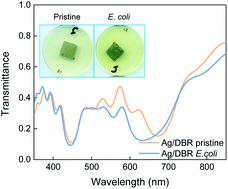当前位置:
X-MOL 学术
›
Faraday Discuss.
›
论文详情
Our official English website, www.x-mol.net, welcomes your feedback! (Note: you will need to create a separate account there.)
Integration of bio-responsive silver in 1D photonic crystals: towards the colorimetric detection of bacteria.
Faraday Discussions ( IF 3.4 ) Pub Date : 2020-03-06 , DOI: 10.1039/d0fd00026d Giuseppe M Paternò 1 , Liliana Moscardi 2 , Stefano Donini 1 , Aaron M Ross 3 , Silvia M Pietralunga 4 , Nicholas Dalla Vedova 1 , Simone Normani 1 , Ilka Kriegel 5 , Guglielmo Lanzani 2 , Francesco Scotognella 2
Faraday Discussions ( IF 3.4 ) Pub Date : 2020-03-06 , DOI: 10.1039/d0fd00026d Giuseppe M Paternò 1 , Liliana Moscardi 2 , Stefano Donini 1 , Aaron M Ross 3 , Silvia M Pietralunga 4 , Nicholas Dalla Vedova 1 , Simone Normani 1 , Ilka Kriegel 5 , Guglielmo Lanzani 2 , Francesco Scotognella 2
Affiliation

|
The colour purity and versatility of fabrication of one-dimensional photonic crystals (1D PhCs) make them ideal candidates for colorimetric sensing of a variety of analytes. For instance, the detection of bacterial contaminants in food via colorimetric sensors can be highly appealing, as most of the existing detection techniques are in general time-consuming and the read-out requires specialised personnel. Here, we present a colorimetric sensor based on hybrid plasmonic/photonic 1D crystals. We demonstrate that the modification of the silver plasmon resonance brought about by the effective silver/bacterium interaction can be translated into the visible spectral region, producing a change in the structural colour. In addition, we observe a superior colorimetric sensitivity against the Gram negative Escherichia coli compared to the Gram positive Micrococcus luteus, a result that we attribute to the more efficient electrostatic interaction and cellular adhesion between the silver surface and the Gram-negative bacteria outer membrane. This approach demonstrates that in principle an easy colorimetric detection of bacterial contaminants can be achieved through the use of bio-responsive plasmonic materials, such as silver, whose selective electrostatic interaction with bacterial cell wall is well-known and occurs without the need of chemical functionalisation.
中文翻译:

一维光子晶体中生物响应银的集成:用于细菌的比色检测。
一维光子晶体 (1D PhC) 制造的色纯度和多功能性使其成为各种分析物比色传感的理想候选者。例如,通过比色传感器检测食品中的细菌污染物可能非常有吸引力,因为大多数现有检测技术通常都很耗时,而且读数需要专门人员。在这里,我们提出了一种基于混合等离子体/光子一维晶体的比色传感器。我们证明了由有效的银/细菌相互作用引起的银等离子体共振的修改可以转化为可见光谱区域,从而产生结构颜色的变化。此外,我们观察到对革兰氏阴性菌具有卓越的比色灵敏度大肠杆菌与革兰氏阳性微球菌相比,我们将其归因于银表面和革兰氏阴性细菌外膜之间更有效的静电相互作用和细胞粘附。这种方法表明,原则上可以通过使用生物响应等离子体材料(例如银)来实现对细菌污染物的简单比色检测,银与细菌细胞壁的选择性静电相互作用是众所周知的,并且不需要化学功能化。 .
更新日期:2020-03-06
中文翻译:

一维光子晶体中生物响应银的集成:用于细菌的比色检测。
一维光子晶体 (1D PhC) 制造的色纯度和多功能性使其成为各种分析物比色传感的理想候选者。例如,通过比色传感器检测食品中的细菌污染物可能非常有吸引力,因为大多数现有检测技术通常都很耗时,而且读数需要专门人员。在这里,我们提出了一种基于混合等离子体/光子一维晶体的比色传感器。我们证明了由有效的银/细菌相互作用引起的银等离子体共振的修改可以转化为可见光谱区域,从而产生结构颜色的变化。此外,我们观察到对革兰氏阴性菌具有卓越的比色灵敏度大肠杆菌与革兰氏阳性微球菌相比,我们将其归因于银表面和革兰氏阴性细菌外膜之间更有效的静电相互作用和细胞粘附。这种方法表明,原则上可以通过使用生物响应等离子体材料(例如银)来实现对细菌污染物的简单比色检测,银与细菌细胞壁的选择性静电相互作用是众所周知的,并且不需要化学功能化。 .


























 京公网安备 11010802027423号
京公网安备 11010802027423号